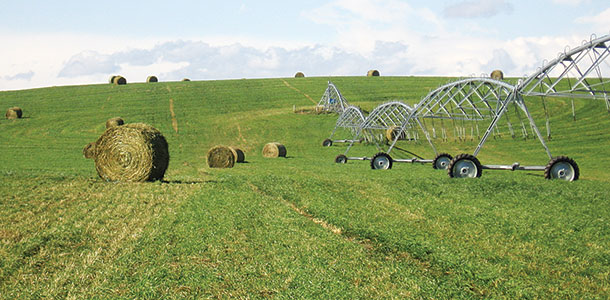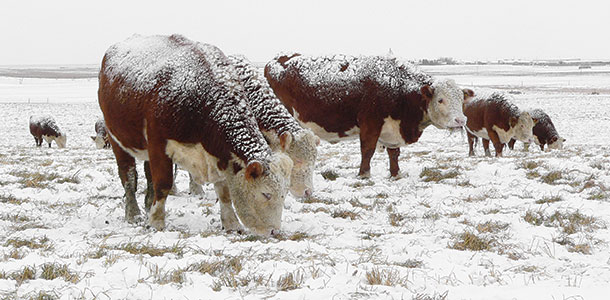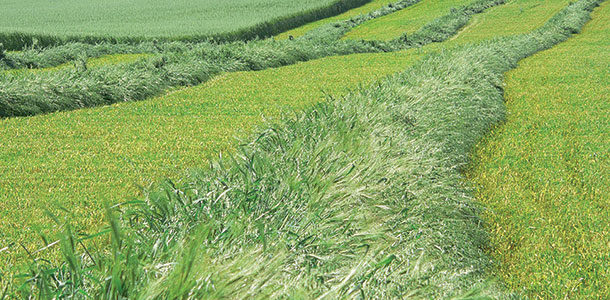Andy Schuepbach, a Hereford breeder in southern Alberta, has been utilizing two varieties of ryegrass to provide fall and winter feed. High protein content eliminates the need for any other protein source.
He grows barley for silage but adds a mixture of Italian ryegrass and annual ryegrass. “The Italian ryegrass is mostly leaves. The annual ryegrass grows taller and gets 6 to 12 inches higher than the barley,” Schuepbach says. It adds more tonnage to the silage, and the plants regrow for fall grazing or hay.
Italian ryegrass has phenomenal feed value, but there is no structure to it – just leaves. “If you try to make hay, you could turn the swath and fluff it up, but if it isn’t quite dry enough to bale that same day – by the next morning it’s flat again,” Schuepbach says.

The annual ryegrass has more structure and dries better, so now he mixes it half and half. He’s not using Italian ryegrass anymore for hay, except a little just for his calves. It has fine leaves and is very palatable, so calves do well on it.
For the last six years, Schuepbach has been grazing most of the ryegrass with cows. “It’s too rich to graze while it’s green, so we graze it in December and January when it’s been frozen and drier.
Even then, it is too good a feed for cows, but they can harvest it themselves and I don’t have to feed hay,” he says.
Schuepbach started doing this when he couldn’t get 100 acres dry enough to bale, even after turning windrows multiple times. “It was cut Oct. 6 and we started grazing it Dec. 6.
We used electric wire and moved it ahead 300 feet every 36 hours. That provided enough feed for 360 bred females for more than a month.”

On Jan. 10 he let them into the last section and took samples for analyzing. The cows had been rolling swaths out of the way to eat the 6 inches of regrowth underneath. “We had to force them to eat the swath before we moved them to the next part,” he says.
The regrowth was 13.2 percent protein and had a 193 relative feed value index. “The dairy industry is interested in hay when it hits 150 or higher, so this grass was nearly straight sugar.
The remains of the swath had a relative feed value of only 109 but the protein content, three months after cutting and being weathered, was 26.3 percent protein. We’ve never tested anything that high,” Schuepbach says.
Ryegrass seed is inexpensive. The main cost is fertilizer. “If you don’t fertilize it to get the regrowth, it doesn’t do very well. But we really like ryegrass because it gives us an extra five to six weeks of grazing in the fall for the entire cow herd,” he says.
Schuepbach’s area is very sandy. Corn would give more yield for silage, but he’s afraid the sandy soil would blow away if tilled for corn. “Italian ryegrass has such an extensive root system, like quackgrass, that it holds the soil,” he says.
“The richer and heavier the soil, the better it does. It likes manure, and in soils with lots of organic matter it does better than in our sandy soil, and doesn’t need much fertilizer.”
Yield depends on weather. “If it’s a hot, dry summer, it makes just a small thin leaf. But as soon as the barley is taken off and you fertilize and irrigate it, the Italian ryegrass really grows.” This provides tremendous fall grazing.
Energy-dense forages
Dan Undersander, extension and forage agronomist, University of Wisconsin, says ryegrass is one of the most energy-dense grasses, used all over the world and parts of the U.S.
“The main issue is it lacks winter hardiness. In the northern half of the U.S. it dies out most winters and must be replanted annually. In the southern half it can persist as a perennial forage,” he says.
“Ryegrass is higher in quality than anything else. The ryegrasses are actually a continuum, varying in energy density from Italian (with highest sugar levels) which some people call annuals, to perennials, and there are crosses between the two."
"We generally think in terms of the diploids for grazing and the tetraploids for haymaking. Tetra means it has four copies of every gene,” Undersander says.
Research on tetraploids in England is developing some high-sugar types, but Undersander thinks we can finish beef on pasture whether or not we have high-sugar types.
“The main thing is to have adequate forage and graze it at an early stage of growth when nutrient levels are highest,” he says.
You need a forage that will grow well in your climate. “Annual ryegrass is ideal, but we can produce good beef on pasture with perennial forages like tall fescues and orchardgrass."
"Ryegrasses need a cool, wet environment; they are not appropriate for hot or arid regions. In those environments we have several other choices,” Undersander says.
Crosses between ryegrass and fescue can work in some regions. “These are a festolium and a little more winter-hardy than ryegrasses,” Undersander says.
The Wisconsin Graziers are now producing seed from a new variety of meadow fescue called Hidden Valley, which has most of the traits of ryegrass but the winter hardiness and drought tolerance of meadow fescue. Meadow fescue will survive winters in cold climates.
“Where we need winter hardiness is usually not right at the Canadian border but a little more south,” Undersander says. Areas with good snow cover most of the winter give more protection to the overwintering plants."
"They survive more readily than in an area where snow comes and goes. Undersander says in central Wisconsin festoliums can survive for three or four years, while in southern Wisconsin they’ve never survived more than one year. FG
Heather Thomas is a freelance writer based in Idaho.
PHOTO 1: Andy Schuepbach windrows Italian ryegrass, as an energy-dense feed, for stockpiled winter feed in southern Alberta.
PHOTO 2: Italian ryegrass has little structure and consists mostly of leaves, so baling it has been challenging. However, calves find the fine leaves very palatable and do well on it.
PHOTO 3: Schuepbach begins grazing in December on stockpiled feed. By January the cows are rolling swaths out of the way to graze the regrowth. Photos courtesy of Andy Schuepbach.
Finishing beef on forage
“The sorghum/sudangrasses are a good choice of annuals for finishing cattle, particularly the BMR types. These annuals grow well in warmer weather – not the best choice in northern states,” Undersander says.
For good productivity, they need 20 to 30 inches of water annually and are most appropriate for wetter regions of the West, Midwest and South, or for irrigated pastures.
“We can finish beef on many kinds of forage, as long as it is grazed when it is leafy, immature and high in quality, with adequate density of stand so cattle can take big bites."
"Cattle take about one bite per second and graze several hours a day. They’ll take 30,000 bites or so. If those are big bites and the forage is high in quality, cattle gain weight. If they are small bites or low in quality, cattle won’t finish as well,” Undersander says.
“The BMR sorghum/sudangrass would be the counterpart to ryegrass for hotter, drier periods of the year. Brassicas like grazing turnips can be a high-quality feed but are much higher in protein than in energy."
"They can be as much as 20 percent protein, which is more than these animals need. They do best in a cool and wet environment and not so well in a hot, dry climate,” Undersander says.
Undersander says chicory is another high-quality forage. “It is pretty good the first year but heads out the second year. You might use it the first year for finishing animals and the second year for younger growing animals that don’t need quite such high-quality feed.” FG











